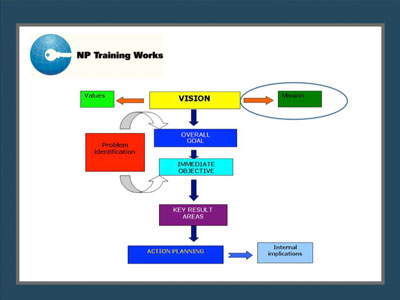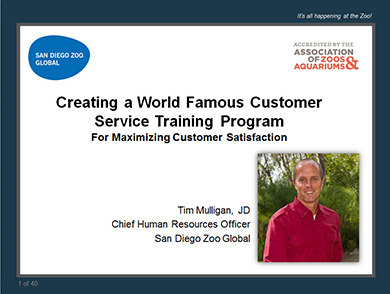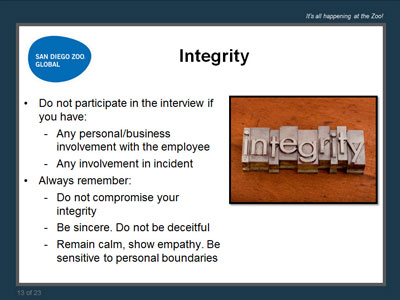 |
Creating and Implementing an Effective Strategic Plan for Your Organization |
1.00 |
Without strategic direction it is hard to get where you want the organization to go. This Webinar offers you a process for reaching your organizational goals. Strategic plans help your organization, or department, set the roadmap to make a significant mission impact. Through this Webinar you will learn a model for completing a Strategic Planning process in your organization. It covers the entire process from planning to defining the strategic framework and then creating a process for implementation activities. You will learn how to create a strategic framework that gives the activities coherence and direction, ensuring that your strategic plan becomes a living, breathing document that is fully utilized in the organization. You will also learn how to involve your board, staff, and other important constituencies in the process to increase your chances of successful implementation. In addition, you will receive leave-behinds that give you practical exercises and instructions to use during your strategic planning process. |
 |
Creating a World Famous Customer Service Training Program |
1.00 |
Are you interested in putting together a unique, world class, and cost effective Customer Service Training Program, rather than just purchasing one "off the shelf?" This webinar will walk you through the steps taken by San Diego Zoo Global to create its GRRREAT! Customer Service Training Program - all done in house! |
 |
Correcting Performance Problems: Providing Feedback To Employees |
0.84 |
By addressing employees who have performance problems, you can help them make positive changes, encourage career advancement, and promote personal and professional growth. Addressing an employee involves providing the feedback necessary to improve performance.
In this course you will learn to: prepare to conduct a feedback session in which you encourage communication with the employee, and conduct a constructive feedback session with an employee who has a performance problem. |
 |
Correcting Performance Problems: Investigating Performance Problems |
1.00 |
Before addressing a performance problem, you should confirm the existence of the problem itself. An interview is a useful method for doing this. During the interview, you might encounter facts that you were previously unaware of and excuses that you didn’t expect. It's important to follow a definite process, and expect the unexpected during the interview.
In this course you will learn to: identify the causes for an employee’s performance problem by interviewing, and question an employee regarding attendance issues, describe the factors affecting achievement, and apply conduct investigation techniques. |
 |
Correcting Performance Problems: Identifying Performance Problems |
1.50 |
An attendance problem occurs when an employee fails to report to work, doesn’t give proper notification of an absence, or exceeds the number of days allotted for absence.
You should address attendance problems carefully. Handling these problems poorly can lead to serious consequences, such as frequent employee turnover or workplace aggression. Before confronting an employee with an attendance problem, you need to identify the type of attendance problem and determine its severity.
In this course you will learn to: identify the types of attendance problems, assess their impacts, and determine a problem’s severity, identify the types of achievement problems, assess their impacts, and determine a problem’s severity, identify the types of conduct problems, assess their impacts, and determine a problem’s severity. |
 |
Correcting Performance Problems: Disciplining Employees |
1.67 |
Discipline is proactive, as opposed to punishment, which is reactive. Punishment provides a consequence to an action that is deemed unacceptable, whereas discipline is designed to exchange undesirable behavior for satisfactory behavior.
The purpose of disciplining an employee is twofold:
1. To correct or eliminate undesirable behavior, and
2. To provide training that improves or strengthens performance.
In this course you will learn to: keep a disciplinary perspective, determine the cause for disciplining an employee, and prepare for conducting a disciplinary meeting, maintain a positive rapport, avoid pitfalls during a disciplinary meeting with employees, and keep meetings productive, and monitor employee performance and conduct a follow-up meeting with the employee. |
 |
Correcting Performance Problems: Addressing Behavioral Problems |
0.84 |
In this course you will learn to: communicate and prevent the discrepancy between an employee’s behavior and performance standards, and identify the type of employee reaction and tackle it effectively.
For a feedback session to be effective, you need to emphasize the impact of the problem behavior to the employee. Their behavior mainly impacts three entities: the organization, co-workers, and the employee. When explaining these factors, you should maintain a proper perspective based on some set guidelines throughout the feedback. |
 |
Conducting World Class Employee Investigations |
1.00 |
Employment litigation and claims in recent years have cost employers billions of dollars. Employers must find ways to reduce their vulnerability to such claims. Often times, employer liability hinges on the quality of the company's investigation into complaints of discrimination, harassment, or other claims of workplace misconduct. In fact, an important consideration in an employee's decision to ultimately file a lawsuit or claim is whether the employer conducted an effective workplace investigation. Join San Diego Zoo Global's Associate Director of Human Resources for a dynamic and informative workshop on how to conduct effective workplace investigations that will protect your organization and reduce potential litigation costs. This comprehensive webinar will include a discussion about:
- A step-by-step approach on how to plan and conduct workplace investigations
- A practical demonstration of effective interview techniques
- How to anticipate and respond to legal and practical issues that frequently arise during the course of investigations
- Preparing bullet-proof documentation to support the investigation findings and recommended actions |
 |
Conducting Meetings: Managing Meetings |
0.67 |
In this course you will learn to: identify the types of meeting leaders and the characteristics of an effective meeting leader. identify the process to follow when making decisions in a meeting, and explain how to identify and minimize group think in meetings. |
 |
Conducting Meetings: Listening Effectively and Asking Questions |
0.50 |
To communicate effectively during a meeting, you have to listen and ask appropriate questions. Listening and questioning are two interdependent skills that will help you create a positive climate, develop positive dialog, and achieve the group’s goals.
By listening and questioning effectively, you’ll actively engage yourself and others in the meeting. Actively participating will enable you to quickly identify and address other participants’ thoughts, ideas, and concerns. Facilitating communication in this manner will foster individual and group success.
In this course you will learn to: identify the main causes of conflict, the ways to resolve conflict in meetings, and the common difficult personality types in meetings, and identify the characteristics of a positive and negative climate, and the steps to build a positive climate when communicating. |
 |
Conducting Meetings: Fundamentals of Conducting Meetings |
0.67 |
Meetings allow groups to function, define goals, contribute to participants’ morale and status, as well as develop organizational culture. During meetings, participants are able to exchange information and update one another on current events. When information is shared among participants, they are able to work together to create ideas and solutions, and make decisions to progress toward the group’s goals.
In order for a group to function effectively, participants must be working toward accomplishing a common goal. Meetings allow participants to define goals as a group, which helps them agree on the terms of the goals, such as how and when they’ll be accomplished.
When the meeting leader encourages input from participants, employee morale increases. Encouraging communication satisfies the participants’ desire to play an active role in the organization. When participants understand that their opinions are valued, they feel that they’ve contributed to their organization.
Meetings also help develop the organization’s culture when meeting leaders demonstrate the values and attitudes preferred by the organization. Leaders display organizational values in meetings to reinforce the behavior they desire from participants.
In this course you will learn to: identify the benefits, types and misconceptions about meetings, plan a meeting, participate in a meeting, and close a meeting. |
 |
Conducting Meetings: Conflicts, Climates, and Difficult Personalities |
0.50 |
In this course you will learn to: identify the main causes of conflict, the ways to resolve conflict in meetings, and the common difficult personality types in meetings, and identify the characteristics of a positive and negative climate, and the steps to build a positive climate when communicating. |
 |
Conducting Meetings: Communicating Nonverbally |
0.50 |
Individuals are always sending messages, unconsciously or consciously, through nonverbal communication. When verbal and nonverbal communication contradicts one another, nonverbal cues are usually believed. Therefore, it is important that you understand what different types of nonverbal communication can mean, and how these messages can influence the productivity of your meetings.
Learning Objectives: Identify the different ways nonverbal messages can be sent. Interpret nonverbal communication and identify the steps to improve nonverbal communication. |
 |
Conducting Meetings: Communicating As Meeting Leaders |
0.50 |
Clarity is crucial for conducting an efficient and productive meeting. By communicating clearly, you’ll be able to express ideas, overcome barriers to understanding, and specify expectations. Your ability to communicate clearly will facilitate interactions among participants, and minimize confusion and conflict.
In this course you will learn to: identify the ways to communicate clearly in a meeting, and identify communication styles to avoid, and the ways to enhance relationships with participants. |
 |
Combating Sexual Harassment in the Workplace |
1.00 |
Welcome to Combating Sexual Harassment in the Workplace. This course was created by CypherWorx in alignment with training materials developed by New York State. While nearly a dozen states have enacted sexual harassment legislation, New York is among those with the strongest and most stringent proposed sexual harassment laws in the nation. (complianceweek.com). This course may be used as a general sexual harassment training, however, you should check with your state and local municipality for other important requirements. |
 |
Coaching: The Coaching Process |
1.50 |
In this course you will learn to: establish a solid coaching foundation by creating and maintaining healthy coach-employee relationships, be an effective coach by understanding your coaching objectives and communicating the expectations and goals to employees, and provide employees with positive and constructive feedback by monitoring and evaluating their performance. |
 |
Coaching: Interpersonal Meetings |
0.75 |
As a coach, your communication skills are critical to your success and the employees you are coaching. In many office environments, it can be tempting to get through the day without much personal contact by relying on technology. However, nothing can replace the benefits of personal interaction, or face-to-face communication. |
 |
Coaching: Fundamentals Of Coaching |
1.00 |
Coaching is the continuous effort to help employees maximize their abilities through personalized counseling and advice. The coaching process not only trains employees to become familiar with business procedures and expectations, but also motivates them to reach both individual and company goals.
Coaching is beneficial to employees because it encourages them to discover their worth and potential. Through proper coaching sessions, employees build confidence, improve their work habits, and increase their productivity.
In this course you will learn to:
1. Define coaching and identify the qualities of an effective coach
2. Build a coaching foundation and plan a coaching strategy. |
 |
Coaching: Communication |
1.00 |
Language is an important coaching tool. The use of suitable words during coaching will help you create relationships, repair employee confidence, and establish plans for employee success. As a coach, you must select words that directly influence your employees’ attitude, behavior, and performance. The use of appropriate language during your coaching sessions will help you convey your messages in a clear and encouraging manner.
In this course you will learn to: clearly express your message by using appropriate language, identify and use nonverbal methods of communication, and receive the desired information by asking effective questions. |
 |
Coaching: Coaching Diverse Employees |
1.34 |
People are different. Beliefs, behavior, learning pace, and personality vary from person to person. Some employees require extensive support to complete a project, while others perform better with fewer guidelines and more control. Still other employees need constant motivation to keep them focused on achieving goals.
As a coach, you must assess each employee’s situation, and determine the most effective coaching approach to implement. This versatility will help you recognize your employees’ needs, improve your communication skills, and make you a better coach.
In this course you will learn to: motivate employees by identifying their individual personality types, and build trusting relationships between employees and their coaches. |
 |
Change Management: Obstacles to Change |
0.75 |
This course will cover how to identify the causes of resistance and the negative reactions to change and the methods for managing them. You will also learn how to identify the causes of complacency and prepare for crisis. |
 |
Change Management: Moving Forward |
0.50 |
This course will cover how to identify the information required and the common responses to the new beginnings phase and identify what people need during this phase. You will also learn how to identify the strategies and communication guidelines to manage the new beginnings phase. |
 |
Change Management: Managing Change |
0.50 |
This course will cover how to encourage creativity in employees and develop a commitment to change in employees. You will also learn how to communicate change effectively, improve listening skills, and control grapevine. |
 |
Change Management: Fundamentals of Change Management |
0.50 |
This course will cover how to identify the levels of change and the misconceptions about change and identify the importance and benefits of change. You will also learn to identify the behaviors and traits of a change leader, and role of resilience during change. |
 |
Change Management: Coping with Uncertainty |
0.50 |
This course will cover how to understand the emotions and responses experienced during the exploration phase, and identify what people need during the exploration phase. You will also learn how to identify the strategies to manage the exploration phase and identify the steps to manage the uncertainty in the exploration phase. |


























